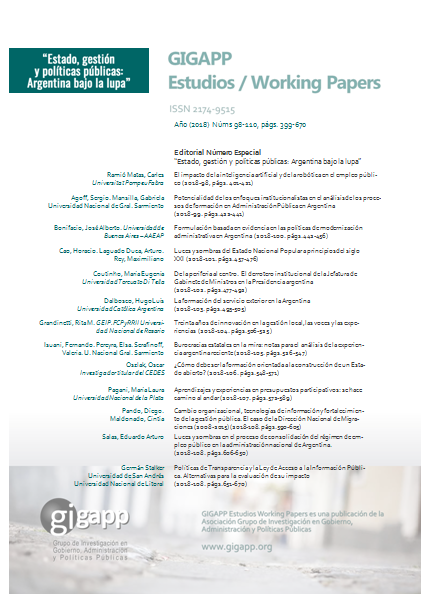From the periphery to the center. The institutional course of the Cabinet Office of Ministers in the Argentine Presidency
Abstract
This article explores the institutional evolution of the Cabinet Office of Ministers of Argentina, since its creation, product of the constitutional reform of 1994, up to the present. It focuses mainly on the organization, on the functions performed and on the profiles of the chiefs of staff throughout the established period. Likewise, it is emphasized that it is important not only to study the organizational transformation of this administrative body, but fundamentally the role it has played in the context of the organization of the Argentine Executive. We argue that this entity originally conceived to deconcentrate and temper Argentine presidentialism, became a powerful tool in the service of the president
Downloads
Copyright (c) 2018 María Eugenia Coutinho

This work is licensed under a Creative Commons Attribution-NonCommercial-ShareAlike 4.0 International License.
Those authors who have publications with this journal, accept the following terms:
a. Authors will retain their copyrights and guarantee the journal the right of first publication of their work, which will be simultaneously subject to the Creative Commons Attribution-NonCommercial-ShareAlike 4.0 International (CC BY-NC-SA Recognition License). 4.0) that allows third parties to share the work as long as its author and its first publication are indicated in this journal.
Under this open access license, readers (users) can:
- Share — copy and redistribute the material in any medium or format
- Adapt — remix, transform, and build upon the material
Under the following terms:
-
Attribution — Users must give appropriate credit, provide a link to the license, and indicate if changes were made. You may do so in any reasonable manner, but not in any way that suggests the licensor endorses you or your use.
-
NonCommercial — Users may not use the material for commercial purposes.
-
ShareAlike — If remix, transform, or build upon the material, users must distribute your contributions under the same license as the original.
- No additional restrictions — Users may not apply legal terms or technological measures that legally restrict others from doing anything the license permits.
b. Authors may adopt other non-exclusive license agreements for the distribution of the version of the published work (eg: deposit it in an institutional telematic archive or publish it in a monographic volume) provided that the initial publication in this journal is indicated.
c. Authors are allowed and recommended to disseminate their work through the Internet (e.g. in institutional telematic files or on their website) before and during the submission process, which can lead to interesting exchanges and increase citations of the published work. (See The effects of open access).



